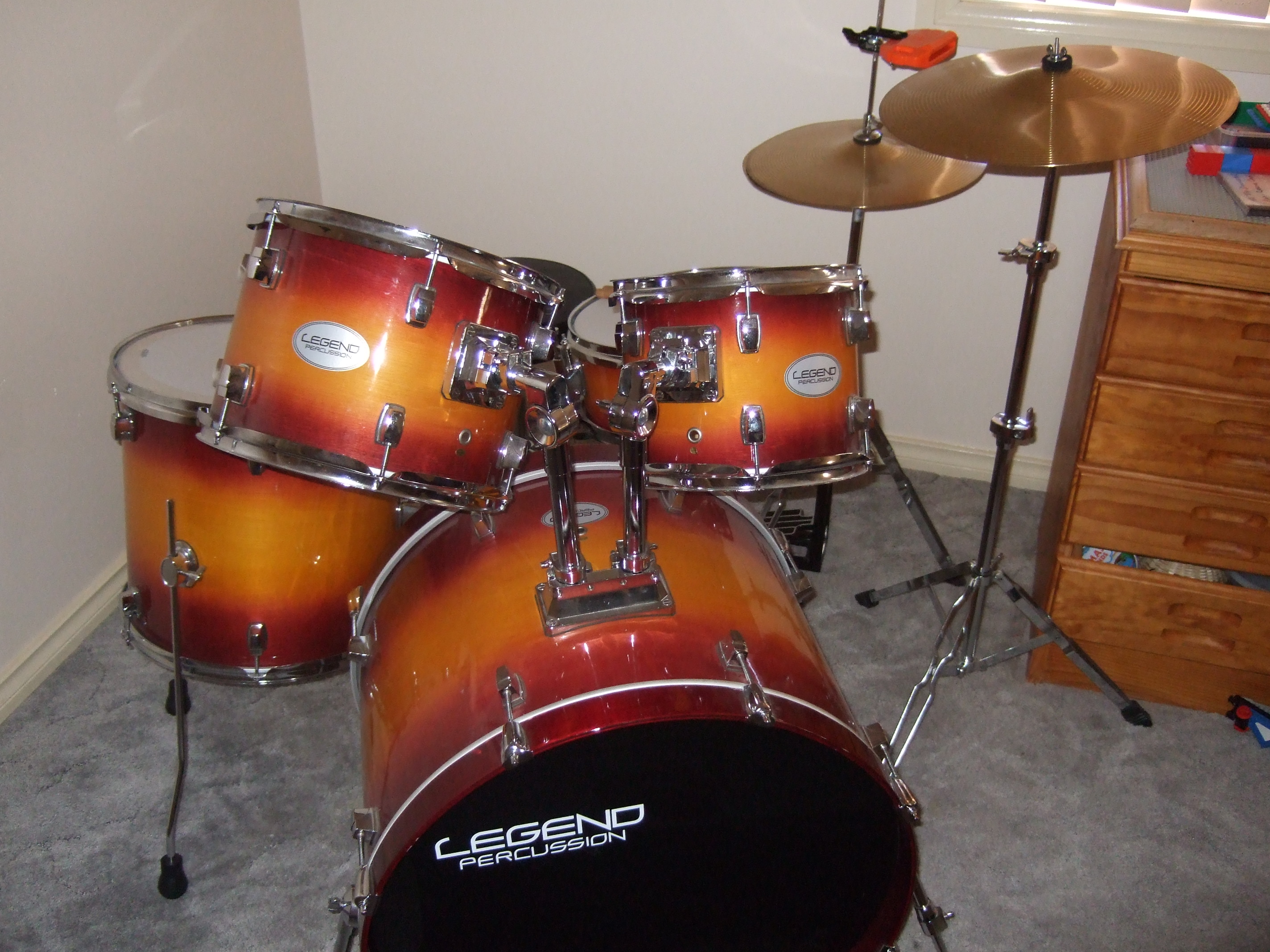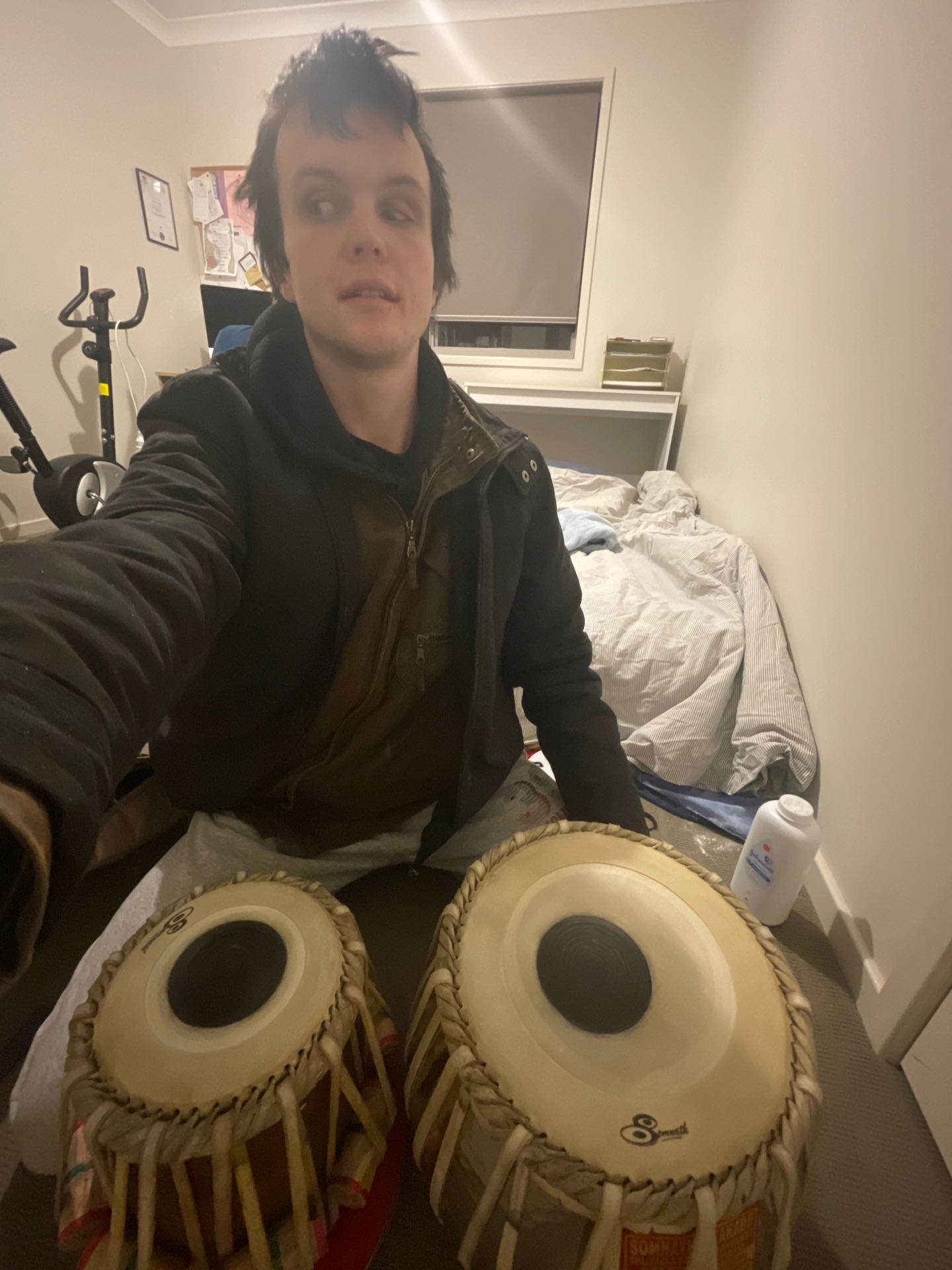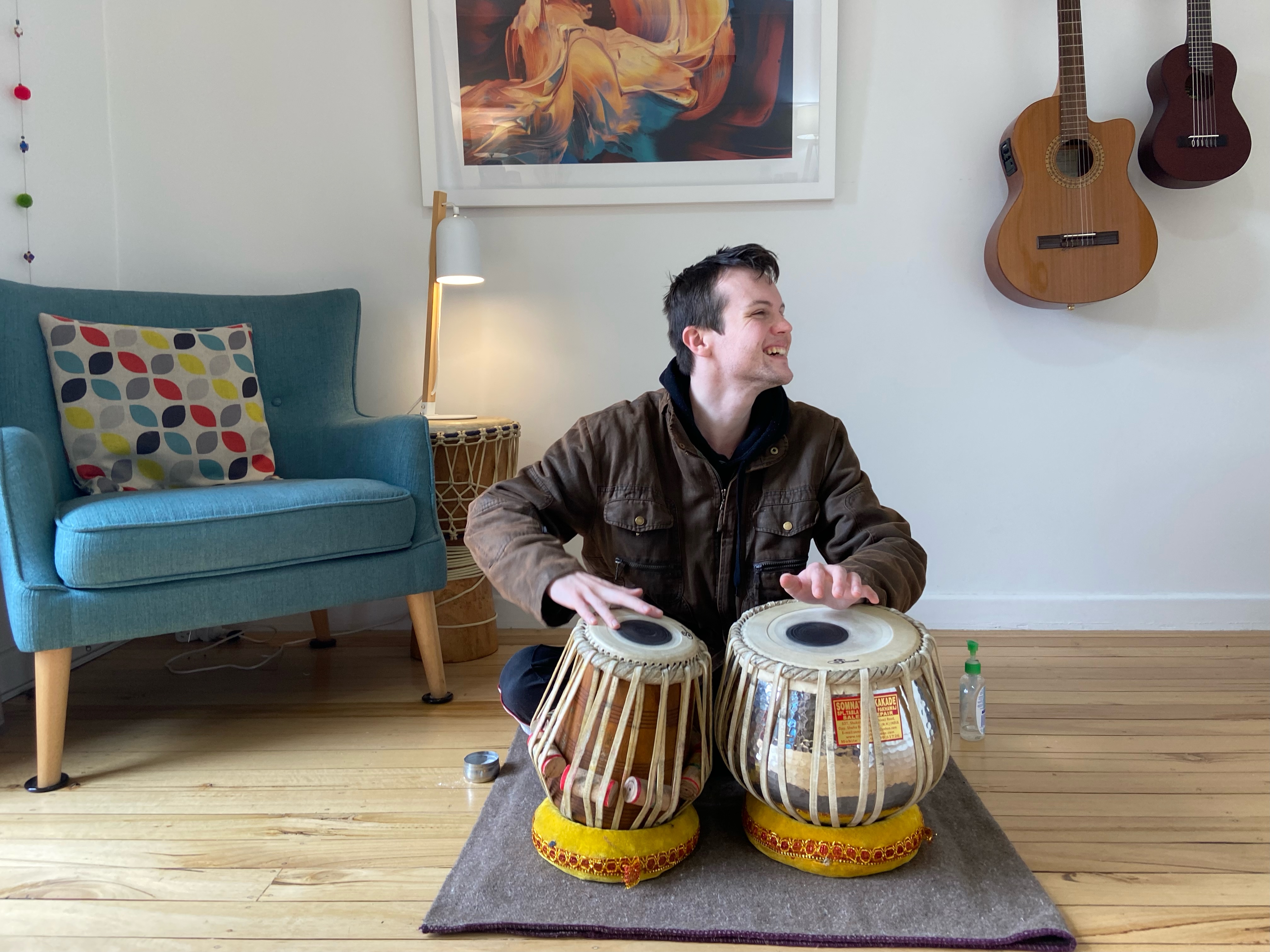Percussio
Percussio is simply a Latin word that is one of the several roots from which the English word percussion is derived. On this page, I intend to put info about any potential personal projects outside of my lessons. There may be videos, or music transcripts. Also anything I learn on the way regarding sourceing, purchasing and accessible ways of playing the drums, as the internet can be a bit of an unreliable source of information for this sometimes; and it is rare if not unlikely that a totally blind person has done this before.
Projects may also be found on Youtube.
Music (Drums and Percussion)

Music (especially rhythm and percussion) has often been a relatively big part of my life. Although my parents were and are not terribly musically inclined playing-wise, my sisters and I must have inherited some kind of gene somewhere, as both of them sing (one professionally), one plays guitar and one or both can play piano to an extent. When I was twelve-years-old, my parents bought me a Legend drum kit (pictured above) for my birthday — yes, I know, drummers will probably cringe at the thought — but it was a good start.
You can watch one of my family’s earlier laid-back parody musical endeavours below, performed in either 2010 or 12, to the tune of ‘Ben’ by Michael Jackson which I played on this kit. It was written by my sisters about the relation to a family friend of ours:
In high school, I played in a school band called Soul Faction which played mostly, broadly in the funk genre. Between roughly 2009–2014, I played the drums for the music team at a Baptist church I used to attend. And from 2017 or maybe 2018–2020, bfore COVID-19 hit the world scene, I played at the Albury Presbyterian Churches’ Morning Church service.
In around 2012 or so, I purchased a Pearl drum kit to go with some Zildjian cymbals I got for my birthday. It served me well enough, although as I was studying and living on campus, it didn’t get used a lot. And then in 2021, I gave the kit to my cousin for Christmas, as I thought he would like it and that the kit would get more productive on-going use that way. I also could not fit the kit into my share house, so it wouldn’t have been able to be used. But I got fidgety, so I started seeking out other options.
Tabla

Tabla is the name usually given to a set of two percussive musical instruments originating from the Indian subcontinent. It can also be given to the daya (right-hand drum) which is the smaller of the two in the set, the other being the dagga, or baya . They are often played sitting cross-legged with the drums in front of the player and sitting on padded rings, allowing for more flexible movement for greater comfort and usability while playing. You can also swap the drums around if you are left-handed; however, the drums still have the same names with their different positions. The treble drum is usually tuned to the tonic note of the musical piece in question. Tabla can usually be found featuring in north Indian Hindustani classical music and sometimes (though less so often) in southern Carnatic classical music. Tabla has also been increasingly introduced to various modern Western styles/genres of music, The Beatles being a noteworthy example of this.
My keen interest in this instrument was inspired by seeing Pete Lockett — now retired — play at Frank Corniola and Drumtek’s Australia’s 17th Ultimate Drummers Weekend in 2009 when I went with my dad. Pete is a world-renown percussionist who, among a number of other things, is possibly most well-known for composing and recording the percussion components of the soundtracks for five of the more recent 007 James Bond films (most notably and substantially, Quantum of Solace). He is also on the International Advisory Board for Can-Do Musos, a not-for-profit organisation for supporting musicians with disabilities, of which I am also a member. I was quite fascinated by his playing and had always wanted to know more. But for a long time, I suppressed my desire for knowledge and experience. My first unofficial drum lesson was from one of my Dad’s first cousins, shortly after I got my first kit in 2006. I recall him saying it only took me about 45 seconds or so to pick up a basic rock beat but don’t ask me how I did that. When I went to high school the following year, I got lessons from Tim Phillips in basic rudiments, then moved onto Doug McGregor who trained me in how to collaborate in a band context. Then I got most of my block of private drum kit lessons from Clint Leys and for a short time, Gary McDonald before I finished my schooling altogether.

Then in around Febrary – March 2022, I started taking lessons with Sam Evans, Ph.D, at the Melbourne Tabla School, who is a senior student of Tabla maestro Pandit Anindo Chatterjee, as well as the late Ustad Zakir Hussain, has a Masters degree in traditional Tabla repertoire and a doctorate in contemporary Tabla performance. In July 2022, I purchased my first complete Tabla set from India direct and by August, I had received it with excellent product quality and delivery service, from Somnath Kakade, a well-known Tabla manufacturer from the city of Pune, who makes tabla in Mumbai style.
Having learned from the traditions of Pt. Chattergee’s style, via Dr. Evans, this means that the beginnings of my tabla repertoire have stemmed mainly from a gharana known as Farrukhabad, as well as occasionally Benares.
It’s going to be a long commitment journey: I’m told about twelve months before I can play in the MTS anual concert; and twelve-eighteen months before I am taught how to tune the drums. The technique is very complex and utterly unlike any drums I have played previously (acoustic drum kit and Djembe). It can take up to three-five years of full-time playing for a drum player to become moderately proficient and a further ten years or so to become professionally adept.
Remembering Ustad Zakir Hussain
Zakir Hussain was one of the most influential tabla players of the 20th-21st centuries. He was a master of both traditional and contemporary tabla repertoire and performance. I remember earlier this year (2024) when I got a retired high school woodwork teacher family friend of ours to make a tool for me to stuff the string back into the two layers of skin for my tablas, he got all excited when he heard me playing, because being really into The Beatles, I don’t think he previously realised that the tabla is one of the unique sounds used for a couple of their songs. The reason why you hear that sound is likely because of Zakirji and his musical contributions with superstars such as George Harrison.
I have always enjoyed listening to his music. Several of the kaidas I know from my teacher are ones he got from Zakirji, such as
dha ti dha ge na dha terekete dha ti dha ge dhii na ge na,
DHANAGEDHETEDHETE DHAGENA DHAGEDHIINAGENA DHETEDHETE DHAGENA DHATIDHAGENADHIINAGENA
DHATREKEDHETETEGENA DHATIGENADHIINAGENA and
Dha tetekredhete dhatetekredhete dhaterekete
thakaterekete dhiinagena dhatidhagenadhiinagena
Unfortunately, he sadly passed away in December 2024. since he made such a big impact and my teacher learned from him for a while, I created a playlist containing some of my own performances that contain some of his kaidas, along with other videos of his own playing that reflect the technical intricacy of his own percussive legacy. You can view it below:
Performances
Hindustani Riyaz (Practice) Session — November 2024
At this riyaz (music practice) session, I did a tabla accompaniment for a sitar recital by Shreya Rana; and a tabla solo of my own, accompanied by Dennis Phelan, who does a lot of the sitar accompaniments at the MTS anual end-of-year concerts.. Enjoy.
Tabla accompaniment for sitar recital, part 1 (recorded by Sumegh Muley):
Part 2 of the same:
Tabla solo (re-hashed 2024 MTS concert piece with the two initial palta included, recorded by Shreya Rana):
The vast majority of it was also recorded by my request from Sumegh Muley:
MTS Concert 2024
Overview:
Group 5 performance (taal – deepchandi/rupak; tempo – 114bpm; piece contains — four tukras (unless one might be a mukra), deepchandi theka, rupak theka, one kaida with six palta and tihai (first two were taken out), as well as a rela (lead into via chand from rupak theka):
Note: the performance starts a bit out-of-sync — this could be because Sam and I were trying to slow it down a bit. But it settles down around the 1min:30sec mark or so.
Sam Evans and Rithvik Chands’ performance:
MTS Concert 2023
Overview:
Group 3 performance (taal – jhaptal; tempo – 60bpm; piece contains — two tukras, jhaptal theka, bhajan theka, one kaida with six palta and tihai, as well as a rela with five palta but these were taken out):
Sam Evans and Rithvik Chands’ performance: because, as always, it was so good!
Hindustani Riyaz (Practice) Session — August 2023
NOTE: I neglected to tune the tabla beforehand: I should have gotten someone else to do it for me, as I can’t [couldn’t] fully do it myself yet.
MTS Concert 2022
In hindsight, it ended up being about eight months before I ended up playing in the MTS concert. Not having a concert in-person for two or three years, owing to COVID-19 lockdowns, caused the performance-ready state of some students to be pushed forward a little. Consequently, there were a couple of noteable mistakes. You can watch the Youtube video of the performance here below:
Obviously, this was an ultra-beginner piece containing a theka (accompaniment piece), and three solo pieces (either a kaida and two tukras, or a kaida, a tukra and a paran — I can’t remember which of the ultimately excluded pieces was a tukra or paran). You can view a much more involved piece, performed in Jhaptal (an eastern equivalent of a tenth-note time-signature in western notation), here to see what tabla is really capable of:
Tabla Resources
Contained below are some resources I have compiled or provided for playing and composition from an accessibility standpoint.
External Links and Websites
- The school I learn at has a collated list of some good resources for both self-teaching and with others including research-based theory, curated music playlists and general tabla repertoire info
- DigiTabla is an excellent resource for learning tabla concepts in theory and sometimes practice.
Practicing and Discipline
There are a number of ways to practice at home, even in hypothetical jamming or performance contexts. One of the main more helpful ways these days is to use phone apps. But one of the problems that often presents itself for a vision impaired third-party app end-user, is that you often cannot know whether an app is necessarily going to be sufficiently accessible or navigable for satisfactory use, unless you trial them first. Sometimes this can result in some moderately expensive endeavours which do not always pay off (no pun intended) if you find that you can’t use the app. I’ve learnt this the hard way in the past, but have also found that it saves you a lot of trouble if, mainly by searching the internet, you can find a precedent — good or bad — from someone else who has gone before you.
When it comes to play-along apps, there is one called Nagma Live which is the only free solution I know of. But you have to pay to unlock most of the instruments and I’m not sure about extra ragas or recorded players. And the interface is reputed to be very clunky and not intuitive, even for sighted users. The app does not use conventional buttons, menus or sliders, so it is a nightmare for a VoiceOver user running iOS.
Another alternative is Prasad Upasani’s iLehra. It costs about $30AUD. There is a relatively thorough and positive review of this app on the AppleVis website by Kushal Solanki.
I wish I had known about this app much earlier than when I actually found out about it. It has been around for a number of years, so it has a fairly extensive repertoire of taals. But it is only available on the Apple App Store which leaves out Google Android users. Furthermore, it does not have a sitar to play along to which may or may not make things a little more difficult if you are a beginner, although a santoor may not necessarily be too difficult to play along to.
A third option is Aman Kalyan of Kalyan Studio Apps’ Lehra Studio series. These are a little more pricy, but that’s probably what you get in value for high-quality original instrument recordings, taals and ragas. The apps are also cross-platform and work on both iOS which you can obtain via the App Store and Android devices via Google Play. The developer is himself a Tabla player from Melbourne and either certainly known to (or maybe even a former student of) my Tabla teacher.
Each app edition in this series is similar but comes with more extensive selections of instruments and talas. The most basic of these is probably Lehra studio itself (I’ve never touched this one). The one my tabla teacher uses and recommends is Lehra Studio Pro. This allows for playing along with a sitar or harmonium, in addition to the sarangi and santoor in the original app. The one I use is Lehra Studio Ultimate, an app which lets you play along to a Bansuri (Indian flute) among others; but unfortunately, it has not carried over the santoor. Lehra Studio Pro costs about $57AUD and Studio Ultimate is about $77AUD.
The graphical interface of studio ultimate is relatively basic; however, most if not all the buttons are not labeled properly which is rather annoying and slows down app usage a lot. If you get someone to talk you through the interface, though, it can be a really easy-to-use app and quite productive for disciplined practice. Once the buttons are manually labeled properly using VoiceOver, it gets even easier.
The really good thing about Lehra Studio is that it is both simple and useful. I think the flute also sounds better and more realistic than iLehra in Studio Ultimate but that could be just personal-preferential bias.
The layout of Studio Ultimate is of a tabular style, which does not work too well with VoiceOver’s flat review cursor style; and the grouped cursor makes no difference. A description of the graphical item layout, from left-to-right, is as follows:
- A menu button on the very left, which contains the following menu items:
- About button for app version info
- Credits for contributors
- Purchase button for purchasing the app
- Decrease pitch button
- Increase pitch button
- An indicator of the current finely-tuned key e.g. “D” or “C#”
- An indication of how many hurtz the pitch is
- After two more unknown items, a slider for the pitch
- After another unknown item, the name of the app section just discussed, namely the “TUNER”.
- Decrease tempo button
- Tempo adjustment slider
- Increase tempo button
- The app section indicator, namely BPM
- The number of beats per minute i.e. 180
- Tap Tempo button which does not appear to do much.
- Next three items appear to be for matra: the number, another BPM text item and the matra screen item
- Next three buttons are selectors for desired instrument, taal and raga. The dimned/technically unavailable text fields say what instrument it is i.e. sitar, bansuri, etc, or what taal or raga you have selected. If you double-tap the buttons, a list of items to select from will appear which you can access by gently dragging your finger (especially if you have 3-D touch enabled) or tapping near the bottom half or maybe even third of the screen. You can also double-tap and hold the dimned text fields for the same menu/list to appear.
- The next three sliders and accompanying text fields allow for adjustment of the selected lehra in question, the tampura and metronome respectively.
In conclusion, interchangeably using Lehra Studio Ultimate and iLehra is a nice combination. They both have their strengths and weaknesses. I think Lehra Studio is nice if you want better quality recorded instrumental music taals.